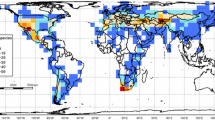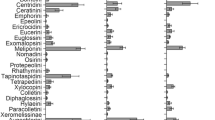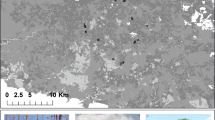Abstract
Bee diversity of the Southwest Pacific has been reported as depauperate despite the otherwise rich biodiversity and complex geological history for this region. However, due to a lack of bee-specific sampling, there is potential for higher bee diversity than previous studies suggest. Here, we review the current literature to summarise the extant diversity for each of the main island groups, the likely passages of species dispersal, and outline the main threats to Southwest Pacific populations. As key pollinators for both cultivated and native angiosperms, ensuring the persistence of native bee populations is critical for both food security and biodiversity conservation. With impending threats from land use change, invasive species and climate change, among others, understanding the true species diversity is important for assigning conservation priorities. We argue that future research in the region must encourage local expertise and build this into global research directions in an effort to address a lack of fundamental knowledge of bee diversity in island ecosystems.

Similar content being viewed by others
References
Aizen, M.A., Morales, C.L., Morales, J.M. (2008) Invasive mutualists erode native pollination webs. Plos. Biol. 6, 396–403
Allen, J., Gosden, C., Jones, R., White, J.P. (1988) Pleistocene dates for the human occupation of New-Ireland, Northern Melanesia. Nature 331, 707–709
Anderson, D.L. (2010) Control of Asian honeybees in the Solomon Islands, CSIRO Entomology Australia. http://aciar.gov.au/project/PC/2004/030 (25 November 2010)
Anderson, D.L., Trueman, J.W.H. (2000) Varroa jacobsoni (Acari: Varroidae) is more than one species. Exp. Appl. Acarol. 24, 165–189
Ascher, J.S., Pickering, J. (2010) World Checklist of Bees. www.discoverlife.org/mp/20q?act=x_checklist&guide=Apoidea_species (25 November 2010)
Batley, M., Hogendoorn, K. (2009) Diversity and conservation status of native Australian bees. Apidologie 40, 347–354
Biesmeijer, J.C., Roberts, S.P.M., Reemer, M., Ohlemuller, R., Edwards, M., Peeters, T., Schaffers, A.P., Potts, S.G., Kleukers, R., Thomas, C.D., Settele, J., Kunin, W.E. (2006) Parallel declines in pollinators and insect-pollinated plants in Britain and the Netherlands. Science 313, 351–354
Brown, M.J.F., Paxton, R.J. (2009) The conservation of bees: a global perspective. Apidologie 40, 410–416
Byrne, A., Fitzpatrick, Ö. (2009) Bee conservation policy at the global, regional and national levels. Apidologie 40, 194–210
Cheesman, L.E. (1936) Hymenoptera of the New Hebrides and Banks Islands. Trans. R. Entomol. Soc. London 85, 169–195
Cheesman, L.E. (1948) Bees of New Guinea and the New Hebrides. Ann. Mag. Nat. Hist. 12, 318–335
Chenoweth, L.B., Schwarz, M.P. (2011) Biogeographical origins and diversification of the exoneurine allodapine bees of Australia (Hymenoptera, Apidae), J. Biogeogr 38, 1471–1483
Cockerell, T.D.A. (1909) Descriptions and records of bees—XXIII. Ann. Mag. Nat. Hist. 4, 393–404
Cockerell, T.D.A. (1911) The bees of the Solomon Islands. Proc. Linn. Soc. New South Wales 36, 160–178
Cockerell, T.D.A. (1916) Some bees from Australia, Tasmania, and the New Hebrides. Proc. Acad. Nat. Sci. Philadelphia 68, 360–375
Cockerell, T.D.A. (1939) XII—Descriptions and records of bees—CLXXV. J. Nat. Hist. Series 11 4, 185–192
Cox, P.A., Elmqvist, T. (2000) Pollinator extinction in the Pacific Islands. Conserv. Biol. 14, 1237–1239
Danforth, B.N., Eardley, C., Packer, L., Walker, K., Pauly, A., Randrianambinintsoa, F.J. (2008) Phylogeny of Halictidae with an emphasis on endemic African Halictinae. Apidologie 39, 86–U42
De Barro, P. (2007) The future of the Australian Honeybee Industry. CSRIO Entomology 1–18
de Queiroz, A. (2005) The resurrection of oceanic dispersal in historical biogeography. Trends Ecol. Evol. 20, 68–73
Donovan, B.J. (1983) Comparative biogeography of Native Apoidea of New Zealand and New Caledonia. GeoJournal 7, 511–516
Donovan, B.J. (2007) Apoidea (Insecta: Hymenoptera). Fauna of New Zealand 57, 295
Eardley, C.D., Gikungu, M., Schwarz, M.P. (2009) Bee conservation in Sub-Saharan Africa and Madagascar: diversity, status and threats. Apidologie 40, 355–366
Evenhuis, N.L. (2007) Checklist of Fiji Hymenoptera, Bishop Museum Techn. Rep. 38
Fitzpatrick, U., Murray, T.E., Paxton, R.J., Brown, M.J.F. (2007) Building on IUCN regional red lists to produce lists of species of conservation priority: a model with Irish bees. Conserv. Biol. 21, 1324–1332
Friese, H. (1909) Die Bienenfauna von Neu-Guinea, Annales historico-naturales Musei Nationalis Hungarici (Termeszettudomanyi Muzeum evkonyve) 7, 179–288
Fullaway, D.T. (1957) Checklist of Hymenoptera of Fiji. Proc. Haw. Entomol. Soc. 16, 269–280
Fuller, S., Schwarz, M., Tierney, S. (2005) Phylogenetics of the allodapine bee genus Braunsapis: historical biogeography and long-range dispersal over water. J. Biogeogr. 32, 2135–2144
Gilman, S.E., Urban, M.C., Tewksbury, J., Gilchrist, G.W., Holt, R.D. (2010) A framework for community interactions under climate change. Trends Ecol. Evol. 25, 325–331
Goulson, D. (2003) Effects of introduced bees on native ecosystems. Annual Review of Ecology Evol. Syst. 34, 1–26
Goulson, D., Stout, J.C., Kells, A.R. (2002) Do exotic bumblebees and honeybees compete with native flower-visiting insects in Tasmania?, J. Insect Conserv. 6, 179–189
Grandcolas, P., Murienne, J., Robillard, T., Desutter-Grandcolas, L., Jourdan, H., Guilbert, E., Deharveng, L. (2008) New Caledonia: A very old Darwinian island?. Philos. Trans. R. Soc. B-Biological Sciences 363, 3309–3317
Hall, R. (2009) Southeast Asia’s changing palaeogeography. Blumea 54, 148–161
Heads, M. (2008) Panbiogeography of New Caledonia, south-west Pacific: basal angiosperms on basement terranes, ultramafic endemics inherited from volcanic island arcs and old taxa endemic to young islands. J. Biogeogr. 35, 2153–2175
Heads, M. (2010a) Biogeographical affinities of the New Caledonian biota: a puzzle with 24 pieces. J. Biogeogr. 37, 1179–1201
Heads, M. (2010b) New Caledonian biogeography: a reply to Murienne. J. Biogeogr. 37, 1627–1627
Hirashima, Y. (1988) Bees of the Genus Palaeoreziza Perkins (Hymenoptera, Colletidae) of Papua New Guinea collected by the Kyushu University Expedition. Esakia 26, 5–19
Howlett, B.G., Donovan, B.J. (2010) A review of New Zealand’s deliberately introduced bee fauna: current status and potential impacts. N. Z. Entomol. 33, 92–101
Kaiser-Bunbury, C.N., Traveset, A., Hansen, D.M. (2010) Conservation and restoration of plant-animal mutualisms on oceanic islands. Perspect. Plant Ecol. 12, 131–143
Kami, K.S., Miller, S.E. (1998) Samoan insects and related arthropods: Checklist and bibliography
Kearns, C.A. (2001) North American dipteran pollinators: assessing their value and conservation status. Conserv. Ecol. 5, 5
Keppel, G., Hodgskiss, P.D., Plunkett, G.M. (2008) Cycads in the insular South-west Pacific: dispersal or vicariance?, J. Biogeogr. 35, 1004–1015
Kohl, F. (1908) Hymenopteren, in: Rechinger K. (Ed) Botanische und zoologische Ergebnisse einer wissenschaftlichen Forschungsreise nach den Samoa-Inseln, dem Neuguinea-Archipel und den Salomons-Insel, Denkschriften der Kaiserlichen Akademie der Wissenschaften, Mathematisch-Naturwissenschaftliche Klasse, pp. 306–317
Krombein, K.V. (1949) Records of Bees from the Solomon Islands with Descriptions of New Sub-species (Hymenoptera, Apoidea). Bull. Brooklyn Entomol. Soc. 44, 10–14
Krombein, K.V. (1950) The aculeate Hymenoptera of Micronesia II. Colletidae, Halictidae, Megachilidae, and Apidae. Proc. Hawaii. Entomol. Soc. XIV, pp. 101–142
Krombein, K.V. (1951) Additional notes on the bees of the Solomon Islands (Hymenoptera: Apoidea). Proc. Hawaii. Entomol. Soc. XIV, pp. 277–295
Magnacca, K.N., Danforth, B.N. (2006) Evolution and biogeography of native Hawaiian Hylaeus bees (Hymenoptera: Colletidae). Cladistics 22, 393–411
Michener, C.D. (1965) A Classification of the Bees of the Australian and South Pacific Regions. Bull. Am. Mus. Nat. Hist. 130, 1–362
Michener, C.D. (1979a) Biogeography of the Bees. Ann. Missouri Bot. Gard. 66, 277–347
Michener, C.D. (1979b) Genus Homalictus in Fiji (Hymenoptera, Halictidae). Pac. Insects 21, 227–234
Michener, C.D. (1980) The large species of Homalictus and related Halictinae from the New Guinea area (Hymenoptera, Apoidea). Am. Mus. Novitates 2693, 1–21
Murienne, J. (2010) Panbiogeography of New Caledonia: a response to Heads (2008). J. Biogeogr. 37, 1626–1626
Myers, N., Mittermeier, R.A., Mittermeier, C.G., da Fonseca, G.A.B., Kent, J. (2000) Biodiversity hotspots for conservation priorities. Nature 403, 853–858
Nunn, P.D. (1990) Recent environmental changes on Pacific Islands. Geogr. J. 156, 125–140
Pauly, A. (1984) Les Homalictus Cockerell (Hymenoptera Apoidea Halictidae) de l’ile Rennell (Iles Salomons), Copenhagen
Pauly, A. (1986) Les Abeilles de la Sous-Famille des Halictinae en Nouvelle-Guinee et Dans Larchipel Bismarck (Hymenoptera: Apoidea: Halictidae). Zool. Verh. 227, 3–58
Pauly, A., Brooks, W., Nilsson, L.A., Persenko, Y.A., Eardley, C.D., Terzo, M., Griswold, T., Schwarz, M.P., Patiny, S., Munzinger, J., Barbier, Y. (2001) Hymenoptera Apoidea de Madagascar. Ann. Zool. Wet. 128, 1–390
Pauly, A., Munzinger, J. (2003) Contribution à la connaissance des Hymenoptera Apoidea de Nouvelle-Calédonie et de leurs relations avec la flore butinée. Ann. Soc. Entomol. Fr. 39, 153–166
Pauly, A., Villemant, C. (2009) Hyménoptères Apoidea (Insecta) de l’archipel du Vanuatu. Zoosystema 31, 719–730
Perkins, R.C.L., Cheesman, L.E. (1928) Hymenoptera—Apoidea, Sphecoidea, and Vespoidea, Insects of Samoa Part V., pp. 1–32
Perkins, R.C.L., Cheesman, L.E. (1939) Halictine bees from the New Hebrides and banks islands. Trans. R. Entomol. Soc. Lond. 88, 161–171
Potts, S.G., Biesmeijer, J.C., Kremen, C., Neumann, P., Schweiger, O., Kunin, W.E. (2010) Global pollinator declines: trends, impacts and drivers. Trends Ecol. Evol. 25, 345–353
Raven, P.H., Axelrod, D.I. (1972) Plate Tectonics and Australasian Paleobiogeography. Science 176, 1379–1386
Rehan, S.M., Chapman, T.W., Craigie, A.I., Richards, M.H., Cooper, S.J.B., Schwarz, M.P. (2010) Molecular phylogeny of the small carpenter bees (Hymenoptera: Apidae: Ceratinini) indicates early and rapid global dispersal. Mol. Phylogenet. Evol. 55, 1042–1054
Rolett, B., Diamond, J. (2004) Environmental predictors of pre-European deforestation on Pacific islands. Nature 431, 443–446
Sarospataki, M., Novak, J., Molnar, V. (2005) Assessing the threatened status of bumble bee species (Hymenoptera : Apidae) in Hungary, Central Europe. Biodivers. Conserv. 14, 2437–2446
Schmid-Hempel, P., Schmid-Hempel, R., Brunner, P.C., Seeman, O.D., Allen, G.R. (2007) Invasion success of the bumblebee, Bombus terrestris, despite a drastic genetic bottleneck. Heredity 99, 414–422
Schwarz, M.P., Fuller, S., Tierney, S.M., Cooper, S.J.B. (2006) Molecular phylogenetics of the exoneurine allodapine bees reveal an ancient and puzzling dispersal from Africa to Australia. Syst. Biol. 55, 31–45
Schweiger, O., Biesmeijer, J.C., Bommarco, R., Hickler, T., Hulme, P.E., Klotz, S., Kuhn, I., Moora, M., Nielsen, A., Ohlemuller, R., Petanidou, T., Potts, S.G., Pysek, P., Stout, J.C., Sykes, M.T., Tscheulin, T., Vila, M., Walther, G.R., Westphal, C., Winter, M., Zobel, M., Settele, J. (2010) Multiple stressors on biotic interactions: how climate change and alien species interact to affect pollination. Biol. Rev. 85, 777–795
Sheffield, C.S., Hebert, P.D.N., Kevan, P.G., Packer, L. (2009) DNA barcoding a regional bee (Hymenoptera: Apoidea) fauna and its potential for ecological studies. Mol. Ecol. Resour. 9, 196–207
Smith, A.G., Smith, D.G., Funnell, B.M. (1994) Atlas of Mesozoic and Cenozoic coastlines, Cambridge University Press, Cambridge
Smith, F. (1879) Descriptions of new species of Hymenoptera in the collection of the British Museum, London
Smith, F. (1953) Catalogue of Hymenopterous Insects in the Collection of the British Museum, London
Stout, J.C., Morales C.L. (2009) Ecological impacts of invasive alien species on bees. Apidologie 40, 388–409
Thomson, J.D. (2010) Flowering phenology, fruiting success and progressive deterioration of pollination in an early-flowering geophyte. Philos. Trans. R. Soc. B-Biological Sciences 365, 3187–3199
Turner, RE. (1918) On the Hymenoptera collected in New Caledonia by P.D. Montague in 1914. Ann. Mag. Nat. Hist. 3, 229–240
Turner, R.E. (1919) The Hymenoptera of Fiji. Trans. R. Entomol. Soc. Lond. 66, 334–346
Walther, G.R., Roques, A., Hulme, P.E., Sykes, M.T., Pysek, P., Kuhn, I., Zobel, M., Bacher, S., Botta-Dukat, Z., Bugmann, H., Czucz, B., Dauber, J., Hickler, T., Jarosik, V., Kenis, M., Klotz, S., Minchin, D., Moora, M., Nentwig, W., Ott, J., Panov, V.E., Reineking, B., Robinet, C., Semenchenko, V., Solarz, W., Thuiller, W., Vila, M., Vohland, K., Settele, J. (2009) Alien species in a warmer world: risks and opportunities. Trends Ecol. Evol. 24, 686–693
Warren, M.S., Hill, J.K., Thomas, J.A., Asher, J., Fox, R., Huntley, B., Roy, D.B., Telfer, M.G., Jeffcoate, S., Harding, P., Jeffcoate, G., Willis, S.G., Greatorex-Davies, J.N., Moss, D., Thomas, C.D. (2001) Rapid responses of British butterflies to opposing forces of climate and habitat change. Nature 414, 65–69
Williams, N.M., Minckley, R.L., Silveira, F.A. (2001) Variation in native bee faunas and its implications for detecting community changes. Conserv. Ecol. 5, 1–24
Williams, P.H., Araujo, M.B., Rasmont, P. (2007) Can vulnerability among British bumblebee (Bombus) species be explained by niche position and breadth?. Biol. Conserv. 138, 493–505
Zayed, A. (2009) Bee genetics and conservation. Apidologie 40, 237–262
Zayed, A., Constantin, S.A., Packer, L. (2007) Successful Biological Invasion despite a Severe Genetic Load. Plos One 2, 1–6
Zayed, A., Packer, L. (2005) Complementary sex determination substantially increases extinction proneness of haplodiploid populations. Proc. Nat. Acad. Sci. USA 102, 10742–10746
Acknowledgements
We thank Sandra Rehan and Luke Chenoweth for valuable comments on this work. We thank Marika Tuiwawa and the South Pacific Regional Herbarium at the University of the South Pacific, Mary Taylor, and Posa Skelton for their ongoing support of our project. SVCG and MPS were supported by grants from the Australian Pacific Science Foundation and National Climate Change Adaptation Research Facility.
Les abeilles dans le sud-ouest du Pacifique: origines, diversité et conservation.
Abeilles / conservation / biodiversité / biogéographie / région Pacifique
Bienen im Südwestpazifik: Herkunft, Diversität und Artenschutz
Bienen / Artenschutz / Biodiversität / Biogeographie / Pazifik
Author information
Authors and Affiliations
Corresponding author
Additional information
Manuscript editor: Stan Schneider
Rights and permissions
About this article
Cite this article
Groom, S.V.C., Schwarz, M.P. Bees in the Southwest Pacific: Origins, diversity and conservation. Apidologie 42, 759–770 (2011). https://doi.org/10.1007/s13592-011-0079-8
Received:
Revised:
Accepted:
Published:
Issue Date:
DOI: https://doi.org/10.1007/s13592-011-0079-8




